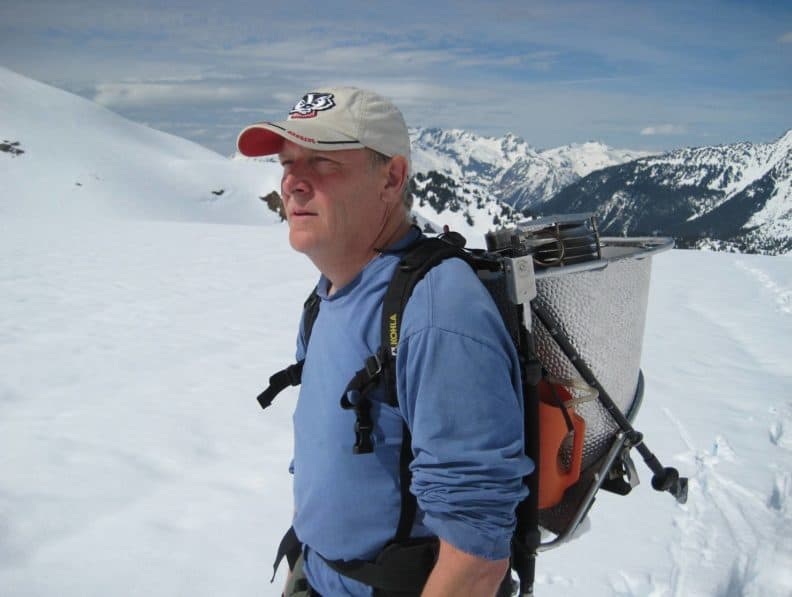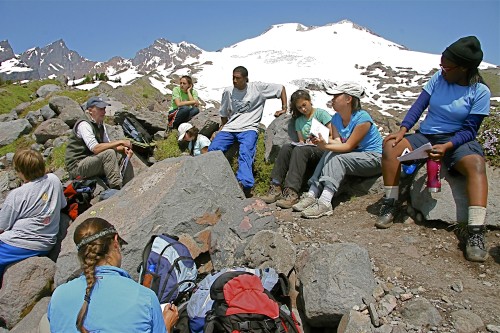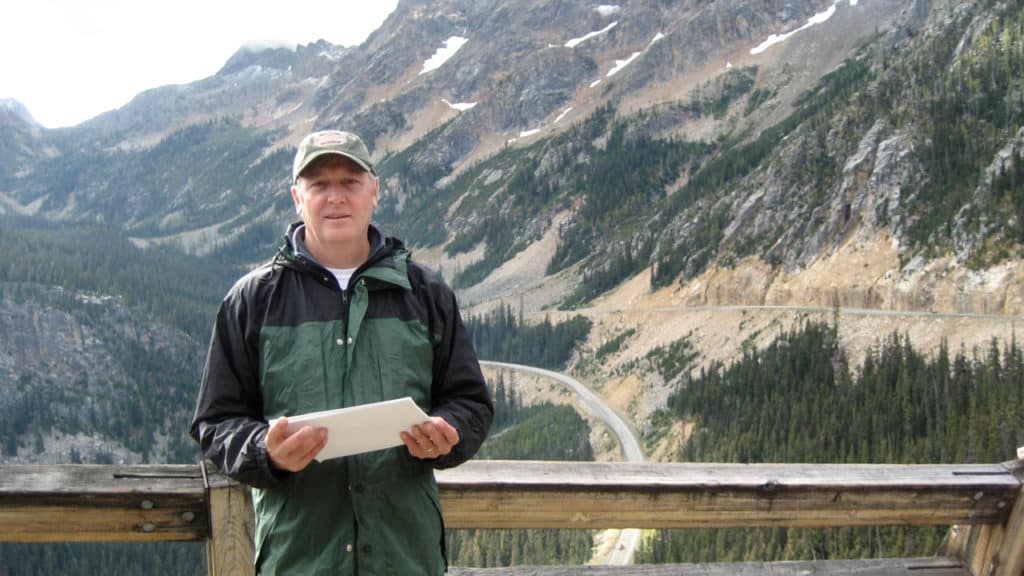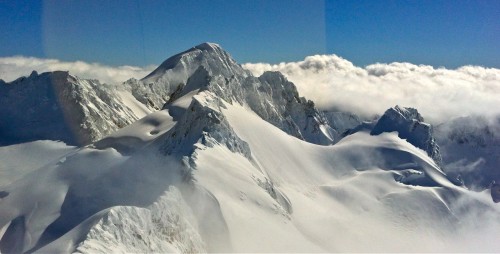
Jon Riedel: Glacier Geologist
What do you do if you are a young midwestern college graduate with a degree in geology and a yearning for adventure, wilderness and outdoor work in the West? “You go to where the action is,” says Jon Riedel, and for him, that meant the North Cascades.
The North Cascades’ superlative features would excite any geologist: it’s the most glaciated region in the Lower 48, with the most vertical relief; the bedrock floor of Lake Chelan sits more than two thousand feet below sea level; dozens of ice ages and glaciations have contorted the landscape into an infinite number of “problems” waiting to be solved. And better yet, the region had largely been ignored by geologists due to its remoteness and difficult access. Riedel found his calling and soon landed a job with North Cascades National Park as a geologist.
“The deductive approaches used in geomorphology—the study of the earth’s surface—caught on with me,” he explains.“The ability to read the landscape and see into the past was intoxicating.”
Coming from the Midwest, Riedel found that everything in the North Cascades was different: the brush was thick and the slopes steep, making exposed rock difficult to find and study sites challenging to get to. So Riedel focused on more easily visible surficial geology features such as alluvial fans, floodplains, terraces, moraines, valleys, and of course, glaciers. With persistence and many miles underfoot, Riedel began to understand what makes the North Cascades unique.

Because the mountains here have been uplifted rapidly and eroded intensely, volcanic rock more common to the south has been stripped away to expose metamorphic rocks brought up from great depths. In the North Cascades, it is possible to access the crystalline core that originated ten miles below the earth’s surface, including Skagit gneiss, the rock that Riedel calls “the backbone of the North Cascades.”
The region’s glaciation history is distinct. The North Cascades were shaped by local alpine glaciers that grew from mountains down to valleys as well as by continental ice sheets moving slowly from Canada to smother the entire range in ice more than a mile thick. Shaped by multiple ice ages, “the North Cascades are a composite of millions of years of glaciations,” says Riedel.

One of Riedel’s most important contributions to the understanding of the North Cascades is his Glacier Monitoring Program, which he started in 1993. The study records seasonal surface accumulation of snow and the loss of snow and ice to melting—annual volume change, or mass balance—of four glaciers at different elevations with different aspects draining to different rivers. Riedel and his team visit the glaciers at least twice a year to take measurements against their melt stakes. They also survey the total area of all glaciers in the national park every twenty years.
“Glaciers are dramatic indicators of climate change,” explains Riedel. “They are sensitive to temperature because that is what determines what form of precipitation falls—snow versus rain—as well as the length and magnitude of the melt season.”
For example, the 1 degree Celsius increase in temperature over the last century has melted half of the glacial area in the North Cascades.
“The loss is staggering,” he says. “When we look at the past twenty years, the North Cascades glaciers have shed four hundred million cubic meters of water loss. This is billions of gallons of water lost into Puget Sound, equivalent to 650,000 Olympic swimming pools, or forty-five years of water supply for Skagit County, or one month of continuous flow of the Skagit River, ten billion gallons per day for thirty days.”
This rapid loss of North Cascades glaciers affects local agriculture, municipal water supplies, industry, hydropower that lights up Seattle, and of course, a broad spectrum of species, from the little-understood ice worms that live on the glaciers to pikas in the alpine zone to the endangered salmon downstream.

“Our biggest glacier is Boston Glacier, at seven square kilometers,” Riedel says. “Compared to the glaciers of the north, that’s nothing, but our glaciers are important ecologically because they provide water in dry summers, buffering capacity, water insurance. The Skagit is the only river in the Northwest with five native salmon, and that’s because of glaciers. They are a source of water and also habitat for ice worms that provide food for other species like rosy finches.
“Climate change is not something projected to happen, it is happening now,” he says in closing. “Everything is tied to climate and everything is in a state of flux right now. Glaciers are a prime indicator of this.”
Originally published in The North Cascades: Finding Beauty & Renewal in the Wild Nearby (Braided River/The Mountaineers Books, 2014), which was nominated for a Washington State Book of the Year award for nonfiction.
Purchase a copy through our online bookstore and support North Cascades Institute’s efforts to get young people outdoors!
VIDEO: Keepers of the Beat: Glaciers are sensitive indicators of climate change. In this video we meet Dr. Jon Riedel, lead glaciologist at North Cascades National Park. Jon shows how he monitors glaciers and explains his reasons for doing so. The film is 18 minutes long and streamed in HD video. If you have a faster connection, click the 1080p setting and use full-screen on your monitor. Turn up your speakers and enjoy.
Photos: top, courtesy of Reidel; middle, Reidel teaches North Cascades Institute students about climate challenge, using Mount Baker as a living laboratory; bottom, glaciers of the North Cascades from John Scurlock’s airplane, both by Christian Martin.


Jon,
I see that you will be speaking in Anacortes next week and I plan to attend. During your presentation could you comment on two questions:
1- Are the Cascade glaciers remnants of the last Ice Age 20,000 years ago?
2- Looking at NOAA climatology for Washington since 1895 there appears to be no trend until the 1980’s when temperature began to increase. Given that, what is the explanation for glacier retreat in the early twenty century?
Thanks
BTW, these are not an anti-climate change questions, just curiosities.